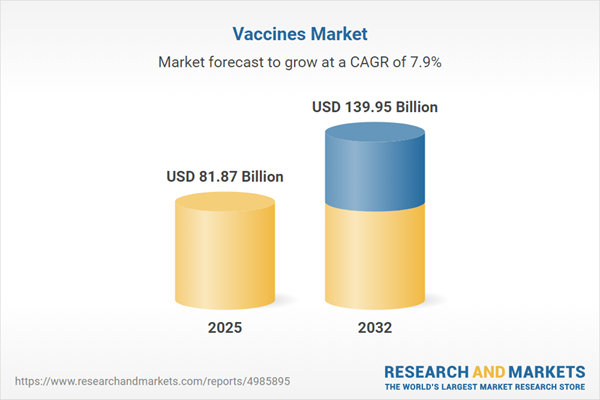Speak directly to the analyst to clarify any post sales queries you may have.
The global vaccines market is experiencing transformative changes in innovation, delivery models, regulatory frameworks, and supply chain strategies—redefining how companies respond to new health threats and opportunities at scale. Senior leaders require a data-driven, actionable overview to inform strategic investments, partnerships, and operational plans.
Market Snapshot: Vaccines Market Size and Growth Trajectory
The vaccines market grew from USD 76.05 billion in 2024 to USD 81.87 billion in 2025. With sustained momentum, it is projected to rise at a CAGR of 7.92%, reaching USD 139.95 billion by 2032. New technologies, evolving regulatory processes, and increased cooperation across sectors are shaping the landscape. Senior decision-makers are recognizing the need for more agile operational models and robust global partnerships in an increasingly competitive and dynamic environment.
Scope & Segmentation of the Vaccines Market
This report provides comprehensive insight into every critical aspect and segment influencing the vaccines market, enabling strategic resource allocation and prioritization. Key coverage areas include:
- Types: Inactivated, live-attenuated, messenger RNA, subunit/recombinant/polysaccharide/conjugate, toxoid, and viral vector vaccines.
- Product Types: BCG, COVID-19, DPTa, Hepatitis A/B, HPV, influenza, Japanese encephalitis, measles-mumps-rubella, rotavirus.
- Vaccine Combinations: Mono-valent and multi-valent options.
- Vaccine Classifications: Preventive and therapeutic vaccines.
- Routes of Administration: Intramuscular, intranasal, oral, subcutaneous alternatives.
- Dosage Formats: Multi-dose and single-dose presentations.
- Age Groups: Adult, geriatric, and pediatric (infant and toddler) populations.
- End Users: Academic/research institutes, hospitals/clinics, vaccination centers.
- Regional Focus: Americas (North America, Latin America), Europe, Middle East, Africa, Asia-Pacific (including China, India, Japan, Australia, South Korea, and Southeast Asia).
- Leading Companies: Market coverage includes global leaders (Abbott, AstraZeneca, Pfizer, Moderna, Serum Institute of India, and more) and innovative biotech firms pushing frontiers.
Key Takeaways: Strategic Insights for Senior Leaders
- Adoption of messenger RNA and viral vector platforms is expanding, accelerating vaccine development and enabling agile responses to new threats.
- Cross-sector partnerships—linking biopharma, academia, logistics, and technology firms—are streamlining distribution and strengthening delivery networks.
- Regulatory harmonization and the use of digital tools are expediting market authorizations, reducing bottlenecks, and improving access.
- Segment diversification, from product type to administration route, underpins opportunities for tailored portfolio strategies and targeted market entry.
- Decentralized and regional manufacturing operations are improving supply chain resilience and adaptability to localized needs.
- Targeted public health campaigns and educational outreach are vital for addressing hesitancy, improving uptake, and supporting community engagement programs.
Tariff Impact: Navigating U.S. Trade Policy Shifts
Recent tariff revisions by the United States have increased costs for raw materials, chemicals, and packaging used in vaccine manufacturing. Companies are responding by revising sourcing, enhancing regional production hubs, and strengthening logistics to minimize disruptions. Customs complexities are prompting investments in automated clearance and compliance, while policy dialogues between trade blocs are driving negotiations for preferential terms and more efficient cross-border flows. Ensuring supply chain adaptability and forming logistics partnerships are now essential for sustained global access.
Methodology & Data Sources
This report is based on primary interviews with industry executives, regulatory authorities, and supply chain leaders, complemented by robust secondary research from academic journals, policy filings, and industry publications. Mixed-method triangulation and expert validation underpin all research insights, providing decision-makers with balanced and actionable intelligence.
Why This Report Matters
- Equips senior decision-makers with clear, segment-level analysis to guide portfolio expansion, M&A, and product launch strategies.
- Enables proactive planning by revealing the operational, regulatory, and geopolitical factors shaping vaccine market evolution.
- Facilitates informed dialogue with partners and stakeholders, supporting risk mitigation and opportunity identification in a rapidly evolving marketplace.
Conclusion
The vaccines market’s expanding complexity demands nuanced strategies and robust partnerships to maintain market leadership. Leverage these insights to anticipate change, optimize investments, and drive sustainable growth in the global immunization arena.
Additional Product Information:
- Purchase of this report includes 1 year online access with quarterly updates.
- This report can be updated on request. Please contact our Customer Experience team using the Ask a Question widget on our website.
Table of Contents
3. Executive Summary
4. Market Overview
7. Cumulative Impact of Artificial Intelligence 2025
Companies Mentioned
The companies profiled in this Vaccines market report include:- Abbott Laboratories
- Astellas Pharma Inc.
- AstraZeneca PLC
- Bavarian Nordic A/S
- Bharat Biotech Ltd.
- Biological E. Limited
- BioNTech SE
- Blue Lake Biotechnology
- Capricor Therapeutics, Inc.
- Chongqing Zhifei Biological Products Co., Ltd.
- CSL Limited
- CureVac N.V.
- Daiichi Sankyo Company, Limited.
- Gennova Biopharmaceuticals Limited
- GlaxoSmithKline PLC
- Haffkine Bio-Pharmaceutical Corporation Ltd.
- Incepta Pharmaceuticals Ltd.
- Inovio Pharmaceuticals, Inc.
- Johnson & Johnson Services, Inc.
- Merck & Co., Inc.
- Moderna, Inc.
- Novavax, Inc.
- Pfizer Inc.
- Sanofi S.A.
- Serum Institute of India Pvt. Ltd.
- Sinovac Biotech Ltd.
- Takeda Pharmaceutical Company Limited
- VBI Vaccines Inc.
- Versatope Therapeutics
- Zydus Lifesciences Limited
Table Information
| Report Attribute | Details |
|---|---|
| No. of Pages | 191 |
| Published | November 2025 |
| Forecast Period | 2025 - 2032 |
| Estimated Market Value ( USD | $ 81.87 Billion |
| Forecasted Market Value ( USD | $ 139.95 Billion |
| Compound Annual Growth Rate | 7.9% |
| Regions Covered | Global |
| No. of Companies Mentioned | 31 |









